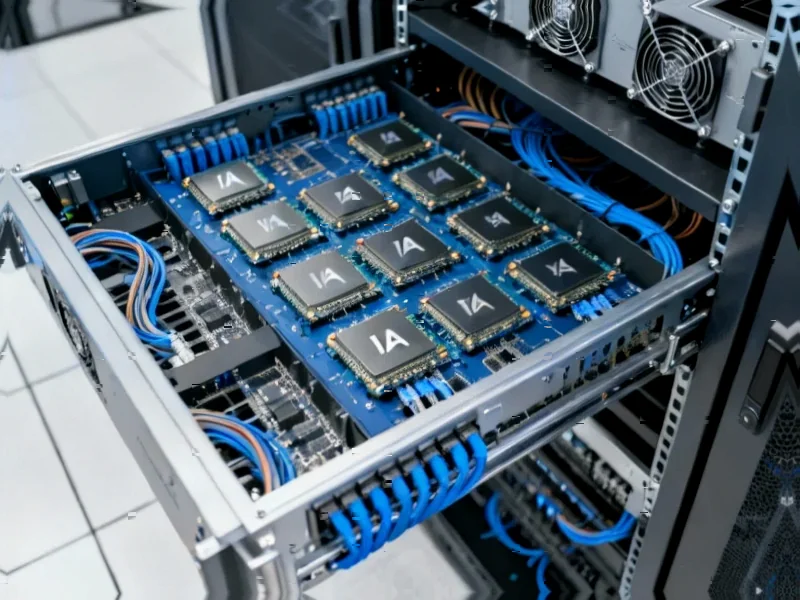According to DCD, Motivair has spent over 15 years cooling the world’s most powerful high-performance computers, progressing from petascale breakthroughs to exascale systems like Frontier, Aurora, and El Capitan. The company’s experience reveals that performance ceilings aren’t set by silicon design alone but by the ability to cool massive power loads, with rack densities now surging to 300-400kW and beyond. Today’s AI factories are preparing to replicate these same thermal profiles across tens of thousands of racks rather than just a handful of supercomputers. The key engineering variables remain pressure drop, ΔT, and flow rate, with modern accelerators requiring approximately 1-1.5 liters per minute per kW at under 3 PSI. Motivair’s precision liquid cooling technology, including CDUs, ChilledDoors, cold plates, and manifolds, enables GPUs to sustain performance without throttling from single servers to multi-megawatt campuses.
From HPC Labs to AI Factories
Here’s the thing that most people miss about the AI infrastructure boom: we’ve seen this movie before. The thermal challenges facing today’s AI factories are essentially the same problems that high-performance computing centers solved over the past decade. When petascale computing arrived in the late 2000s, racks started pushing beyond 20-50kW, and air cooling just couldn’t keep up. The leap to exascale was only possible with liquid cooling.
But now we’re talking about scaling those solutions from a handful of national lab supercomputers to thousands of commercial data centers. The physics hasn’t changed – GPUs still need precise cooling to hit their performance targets. What’s different is the economic stakes. In HPC, a mismanaged cooling loop might cost millions in lost research time. In AI factories, where training runs can consume billions of dollars in compute time, thermal mismanagement becomes existential.
Why Pressure Drop, ΔT, and Flow Rate Matter
Basically, if you’re not thinking about pressure drop, ΔT, and flow rate, you’re not really thinking about liquid cooling. Excess pressure resistance kills efficiency and creates uneven chip cooling across thousands of GPUs. Delta T that’s too small wastes capacity, while too large pushes silicon outside safe operating ranges. And flow rate? Modern accelerators need that sweet spot of 1-1.5 liters per minute per kW.
Get any of these wrong, and your expensive Nvidia or AMD chips get thermally throttled. They’re still functional, but they’re not delivering the performance you paid for. The entire data center effectively gets derated. That’s why companies like Motivair are applying their exascale expertise to AI scale – because the fundamentals remain constant even as the stakes multiply.
Where This Is Headed
Looking ahead, silicon roadmaps are moving toward denser cores, advanced HBM, and liquid-first designs. We’re not just talking about cooling as an afterthought anymore – thermal management is becoming foundational to chip architecture. Systems like Frontier, Aurora, and El Capitan showed us the ceiling: thermal management defines what’s computationally possible.
Now imagine that same principle applied across entire AI campuses. The companies that get liquid cooling right – that can deliver modular, repeatable, serviceable cooling infrastructure at factory scale – will have a significant competitive advantage. We’re moving toward a world where cooling systems don’t just support compute performance – they enable it.
Cooling as Competitive Advantage
So what does this mean for the AI industry? The revolution won’t be defined by chips alone, but by the cooling systems that let them run at full potential. Every watt of compute requires more than a watt of thermal planning. Companies like Motivair that cut their teeth on liquid cooling systems for exascale are now positioned to enable AI at global scale.
Their Coolant Distribution Units, ChilledDoors, cold plates, and manifolds represent the bridge between HPC expertise and AI factory requirements. And with partners like Schneider Electric in the ecosystem, we’re seeing the maturation of liquid cooling from specialized solution to mainstream infrastructure.
The bottom line? If you’re building AI infrastructure and not thinking about liquid cooling with the same seriousness as your silicon selection, you’re already behind. The companies that will win in the AI era understand that thermal management isn’t just about preventing failure – it’s about unleashing performance.




